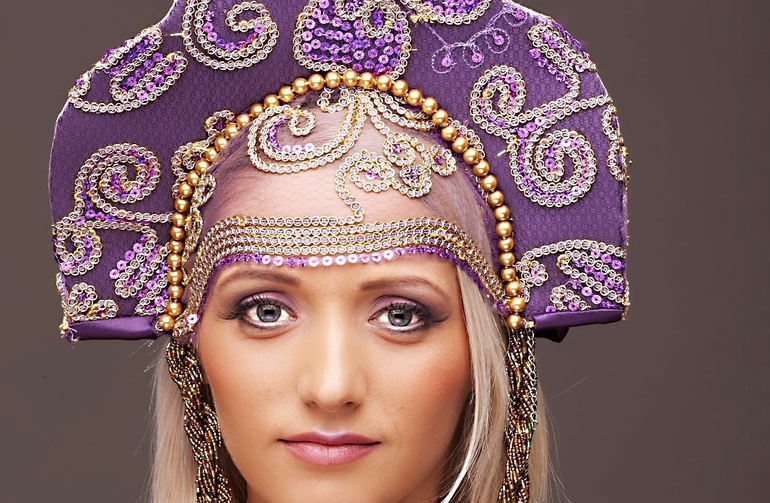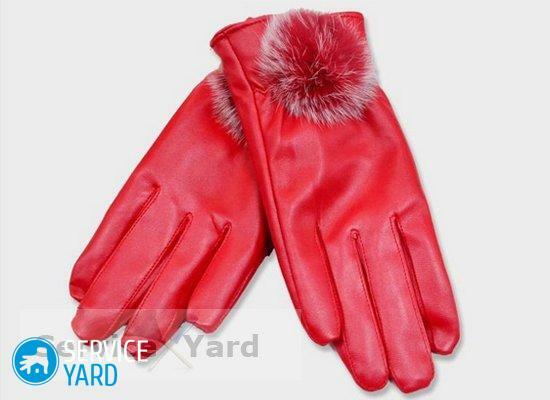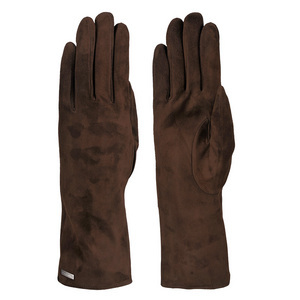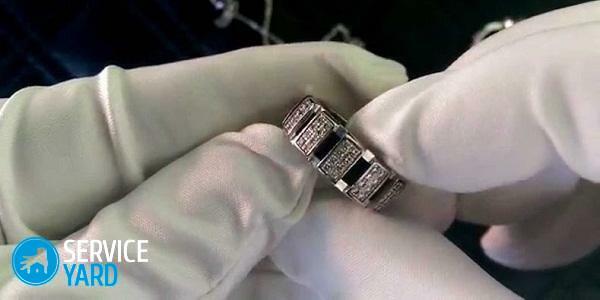Ancient Russian headdress kokoshnik got its name because of the similarity with the crest of the cock or hen. Now it is almost never wear in everyday life - it is only used in festive dresses and national costumes for dance, folk festivals and performances. Kokoshnik can produce their own hands made of paper or fabric.

Content
- The apparatus and appearance
- product shape
- wearing tradition
- Master classes on manufacturing
- Sewing fabric
- Kokoshnik cardboard
- hat Snow Maiden
The apparatus and appearance
Kokoshnik light looks like a woven, paper or metal fan, which is attached to the cap or Volosnikov. It consists of nachelnika and stems, which are behind the tape down. Kokoshniki made traditional silk and velvet, they are also made of calico, canvas, cardboard or paper. headdress crest is richly decorated: decorate it with beads, beads, gold thread, foil, glass, brocade braid, flowers, precious stones.

Traditional headdress worn in the ancient Rus, usually encrusted with pearls. At their edges allowed Ryasnyi (pearl dangling strands decaying on the shoulders of women), and the ridge trimmed mesh. Together with innovative translucent often wore fancy shawls, veil or veil, which descend from the top hat forward, backward or to the sides.
This old piece of clothing was considered a holiday, because it is always richly decorated. He draws attention to the face, framing it, but not closing. This gives the woman a noble kind, because he later became part of the traditional dress of the ladies.
product shape
Combs kokoshniks can vary greatly in form. Their differences were primarily due to the peculiarities of traditional hairstyles of various regions of the country. Traditional crest adorned the blades and other parts. Distinguish forms hat:

- Horned. Traditional kokoshnik. Usually it combined with podnizyu-grid, which hung from the rim of the upper part and closing the face girl almost to the level of eyebrows.
- Horned. Cover with high hu in the form of a triangle or half-moon with drooping ends at the shoulders. It is large - scale comb could be up to 60 cm.
- Taper. It has an elongated front part. Traditionally decorated not only with gold thread and pearls, but cones - a symbol of fertility.
- In the form of caps. Kokoshnik high hu, which ends with a flat top with slightly rounded edges.
- Cylindrical. Is small blades barely covered her ears. Is attached to the head of a hard strip of fabric sewn rear and the front is decorated with netting.
- Odnodvorchesky. Worn with Kichko and nalobnik. It has no blades, lining under the back of the head or spider veins.
- Oval. It has a flat oval tip of the protrusion above the forehead and above the ears of the blade. Rear fixed rectangular piece of cloth.
- Dvugrebenchaty. Top of the kokoshnik is shaped like a saddle with a slightly raised front and rear high crest.

The oldest form of these dresses are those that have a direct crest sits on a flat basis, covering the head from ear to ear. There are also more exotic kokoshniki dome-shaped crown, and so on.
wearing tradition

The exact time of occurrence kokoshnik known as the full history of its origin, but already in the X century like his products have been a familiar part of clothing in Russia. Until the twenties he was a part of the headdress of the bride, who wore a young wife before the birth of the first child, and then remove and put on only on holidays. Now this garment virtually disappeared from everyday life and is used as part of carnival costumes and clothes for performances.
Kokoshnik are made to order. It can be purchased from professional masters - kokoshnits who possessed all the necessary to create headdress skills and able to handle not only the tissues, but also with natural pearls, gold thread and beads. Price is particularly expensive products reached 300 rubles in banknotes (compared to a strong peasant horse was worth 60 rubles), because kokoshniki often become heirlooms. They tried to carefully cherished and passed down from generation to generation.
Wore this dress only on holidays - it was intended to underscore the solemnity of the case. On ordinary days, women wore nakosniki and ochipok. Traditional hairstyle for kokoshnik were two braids, laid a wreath or beam. Headdress completely covered the hair of a married woman, but there were maiden kokoshniki, allowing to do and other hairstyles.

A distinctive feature of hat - crest. He could be in the shape of a crescent, and in the form of an arrow, circle, triangle, crown, fan. In ancient times, the shape of the hat could identify the province, from which she came. He played a big role as an ornament. Traditionally, it consisted of frogs, which symbolized fertility, and two swans that are associated with fidelity. The back side is also decorated kokoshnik - usually located there drawing the tree of life.
Normally, this piece is associated with weddings. He is sometimes referred to in the texts of ancient prayers of marriage and family. When kokoshnik began to replace traditional scarves and hats, in some places it is still maintained as part of the wedding tradition - for example, the bride and groom the girls wore them three days after the celebration. On such a special occasion it was decided to put on pearl kokoshnik - even if the bride's family could not afford it, they had to borrow a costume element from neighbors or acquaintances.
The word "kokoshnik" was first documented in the XVII century. Under Peter the Great, he was forbidden to wear among the courtiers, but preserved as a part of the wedding tradition. Tsarina Catherine II returned part of the traditional Russian costume in everyday life. During the Napoleonic wars, he again came into vogue because of the ensuing burst of patriotism, and the revival of interest in the traditions. It was worn by even the Russian Empress.
According to the decree, which is published Nicholas I, kokoshnik became part of court dress. Maid of honor wore it until the Revolution. In the XIX century, followed by another surge in popularity of this attribute. Ladies put on dances and celebrations ornate and often "exaggerated" version of the traditional corbel, which demonstrated the luxury and richness of the costumes.
Master classes on manufacturing
Manufacture kokoshnik alone can any adult. There are several variants of this hat from simple products made of cardboard and to complex and ornate crowns of different shapes and sizes. The top of the product do stencil paper.

Kokoshnik own hands is usually made on the frame. His sheathe paste or cloth, and then decorate on your own. Decor items - one of the most important parts of its production, but about him is difficult to give any advice, because everything depends on the taste of the owner and other parts of the costume style.
Sewing fabric
Kokoshniki come in all shapes and sizes, from simple crescent to the crown. Everything depends on the stencil. To make a traditional headdress with their own hands, you will need:

- cardboard for the base;
- the cloth;
- scissors;
- several rubber bands;
- tape;
- crystals, beads and other optional inlay.
The fabric can be selected as desired depending on the purpose hat. Kokoshniki come in all shapes, sizes and colors, because the final appearance of the product depends largely on taste and imagination. Step by step instructions for the manufacture of the garment:

- The first thing you want to print kokoshnik pattern of paper or draw it yourself. The second variant is preferable as another workpiece is likely to have to alter the size of the head.
- Cut a piece of cardboard the pattern selected. Make two patterns with allowances made of thick fabric, attached to the cardboard template and sew.
- Cut the rim - a dense and fairly wide strip of cardboard. Sheathe the cloth in the same manner as the base. Attach the tip to the rim kokoshnik and sew, without forgetting to smooth cloth. Between the parts must turn right angle.
- Trim any excess tissue or if there is a sewing machine, sew edge products to overlock. To sew the edges kokoshnik two tapes - it will be strings. If desired, you can also fill up piece band, so it is better to stand on your head.
- Decorate the base and rim tape, ribbon motifs, sequins, stones and other decorations at the discretion.
This workshop is suitable for the manufacture of kokoshnik for girls and for adult women. If desired, one can reduce the proportion of the product and make a doll. working with the material principles do not change depending on the size.
Kokoshnik cardboard
If desired, can be made Russian folk kokoshnik with their hands out of cardboard, without having to work with needle and thread. To do this, you need to take these materials:

- thick cardboard;
- the cloth;
- scissors;
- glue;
- tape width of 1 cm;
- jewelry and accessories on request.
Make a piece of cardboard will be easier than to sew. on its manufacturer's instructions:
- Cut cardboard blank in a crescent shape (size pick up by the head length from ear to ear). Retreat from the lower edge of 2 cm and hold it parallel to the line. Push it and bend of the resulting outline.
- Make two pattern from tissue of the same size, leaving a seam allowance width of 1.5 cm. Apply glue to the edges of the carton blank and attach the fabric tautly. Tuck the edges and fix them on the back side of the hoop.
- To the underside preform sticking tape-eyeballs. Then, attach the other piece of fabric to hide the error.
- Decorate and decorate kokoshnik lace, lace and other decorative elements as desired.
This piece is well kept on the head and easy to manufacture. The disadvantages of this option include the fact that it leaves little room for experimentation with the form of caps.
hat Snow Maiden
Kokoshnik component is headgear Maiden, which can be made to suit children's Christmas. You will need:

- solid wire;
- thick cardboard;
- scissors;
- glue gun;
- damask sheet;
- little tulle to decorate;
- Letna adhesive;
- needle and strong thread;
- Beads, sequins, crystals, stones, snowflakes and other little things for decoration.
Preparing the materials, you can create kokoshnik for Snow Maiden with their hands. Master-class on making:

- To heavy and ornate headdress sat well on the head, it should be done on individual measurements. The basis of the product is the metal frame of the wire. He needed to give proper shape, securing with adhesive tape if necessary.
- Cut out a cardboard rim of the frame size. Glue it to the base using a glue gun. For reliability sew edges durable thread.
- Textile cutting the size of the hoop, leaving about 3 cm for seam allowance. Glue it to the back side of the fabric and sew thread, covering the cardboard rim.
- Attaching an upper portion of the frame to the paper, cut the tip of the crown. If desired, you can change its shape, adding a symmetrical hill, roundness and patterns or cut the tip in the form of Christmas trees, but it is important to keep the size.
- Make preform tissue (without allowance) to the size of the resulting preform. Glued to the frame using a glue gun. To the rear of the rim piece to sew tulle.
- Decorate the front of the headgear. The edges can be clad or make patterns out of fabric, and the bezel decorate hanging beads or wide translucent ribbons. To decorate the top of the Snow Maiden kokoshnik well suited stones or large beads.
On manufacturing kokoshnik will leave no more than a few hours. This piece can be used as the Snow Maiden costumes, Russian beauties Maria, the princess and the other characters.



